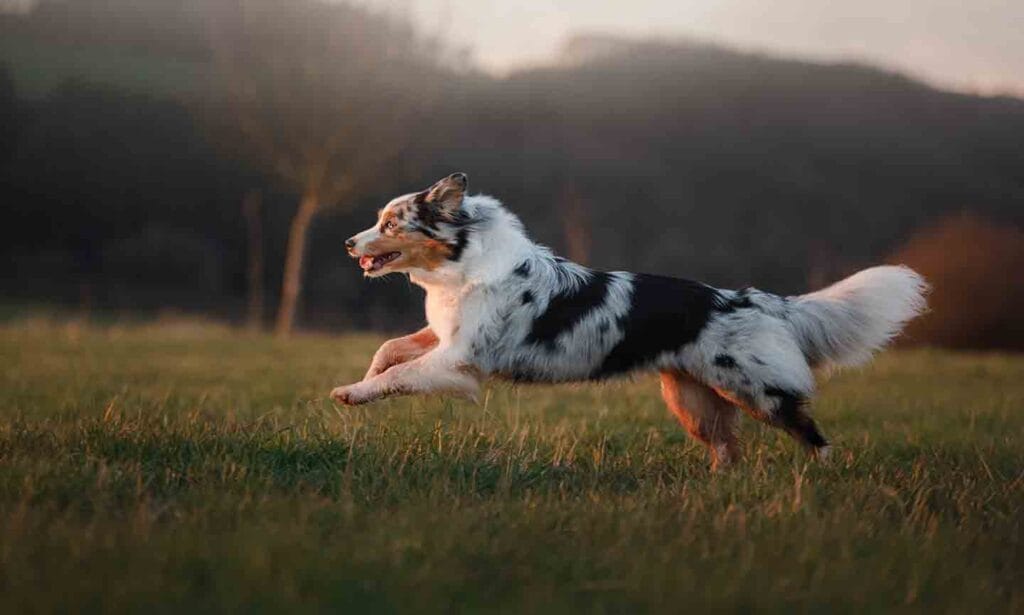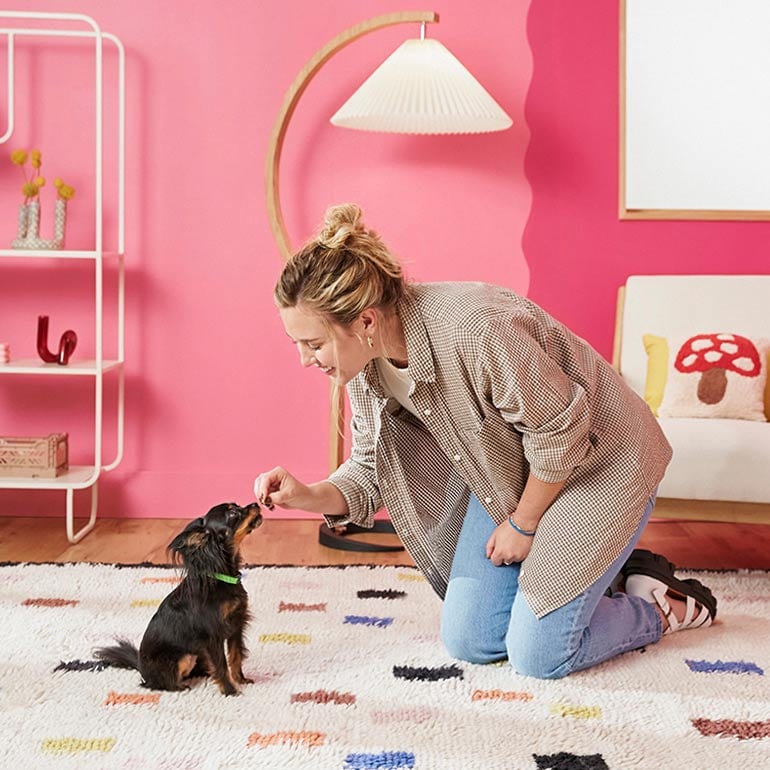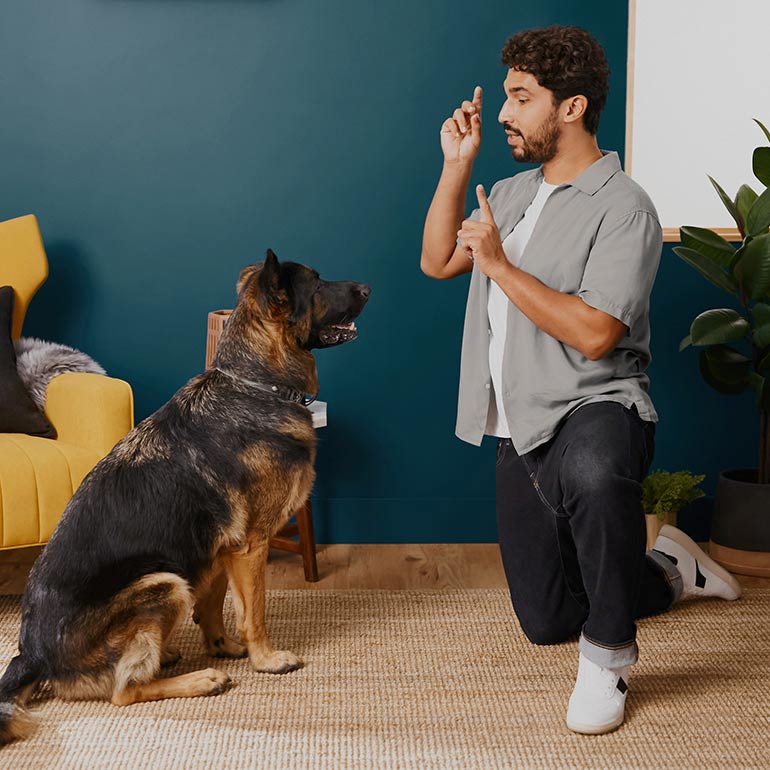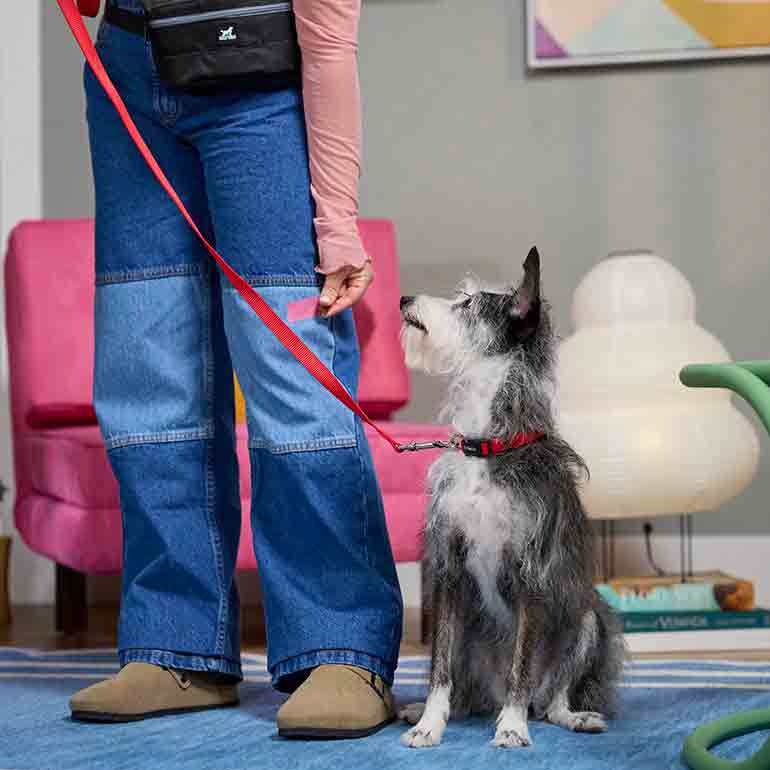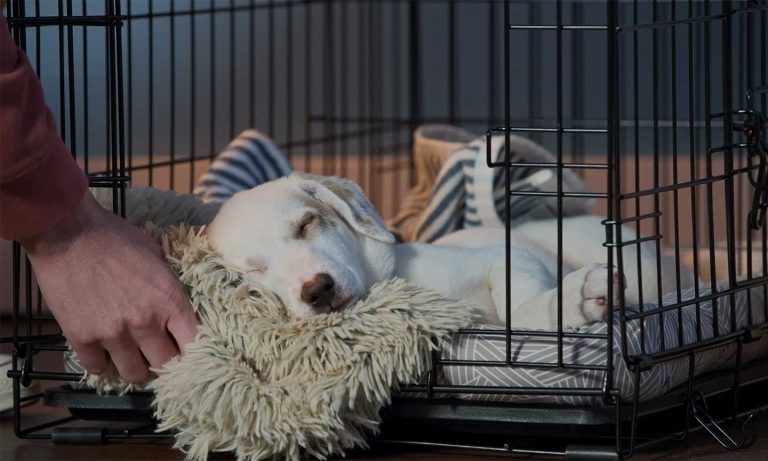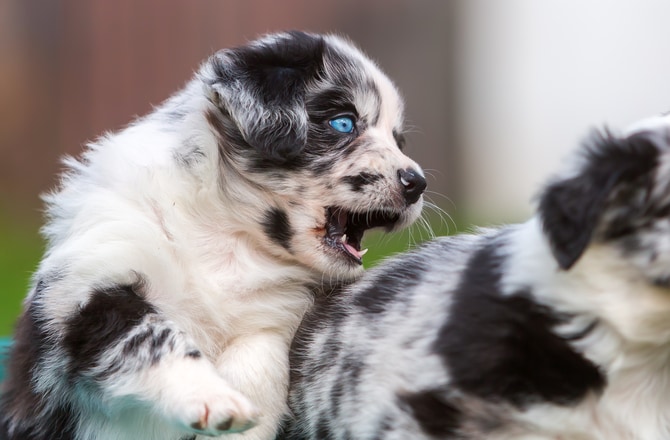Of all your responsibilities as a dog parent, keeping your pup safely nearby and out of harm's way is a top priority. This includes training your dog not to run away, and all the other commands—like sit and stay—that can help ensure they stay put in everyday situations. It also means understanding some common triggers that may cause them to run away—like loud noises or thunderstorms—and securing your home if your dog has escape artist tendencies.
Ahead, we’re teaching you how to train a dog not to run away; offering guidance on how to train a dog to be off leash; and covering some common reasons dogs run away—and the best thing you can do if this does happen. Our guidance applies whether you’ve got a new puppy or a fully-grown dog, so keep reading.
In This Guide
How to Train a Dog Not to Run Away: A Step-by-Step Guide
Teaching your dog to not run away involves teaching them specific, small cues that ensure they remain by your side. This process takes time, but the effort is well worth it.
“Dogs thrive on consistency and structure,” says dog trainer Sylvia Wilson, co-founder and certified trainer with Bark Busters International. “A dog well-bonded to its owner or family unit is less likely to escape when its needs are met. Understanding your dog’s canine nature and providing proper education through training and routine is key.”
Here are some steps you can take to teach your dog to not run away.
1Teach Basic Cues Like Stay, Sit, and Heel.
Simple obedience training is step one in keeping your dog safe and preventing them from running away. We’ve covered all of the essential commands in our comprehensive basic dog obedience guide.
2Prioritize Recall Training
Teaching your pooch how to come back to you when their name is called is another element of their basic obedience education. The cue for this is “come.”
Effective recall training is essential for your dog's safety since it allows you to call them away from potentially dangerous situations, off-leash areas, or simply to have them return to you during off-leash walks or outings. Here’s how to teach a dog to come in just five steps.
Practice all the above cues both at home and in areas where there’s some distraction, so it can better prepare your pup for real-world scenarios when they’ll need to follow your orders.
3Provide Positive Reinforcement
When your dog obeys your cues, make sure to provide positive reinforcement. This involves lots of vocal praise, yummy treats, and loving affection. Make sure to do this at home and in public. You want to make sure they associate their good behavior with being rewarded.
4Remain Consistent and Patient
Preventing pups from running away is a lifelong practice. As such, dog parents must remain consistent in their cues and rewards, and practice patience at all times.
“Consistency allows dogs to settle into predictable behavior patterns,” Wilson says. “By being reliable leaders, dog owners can teach their pups that running away isn’t acceptable, and that home, or nearby their owners, is where they belong.”
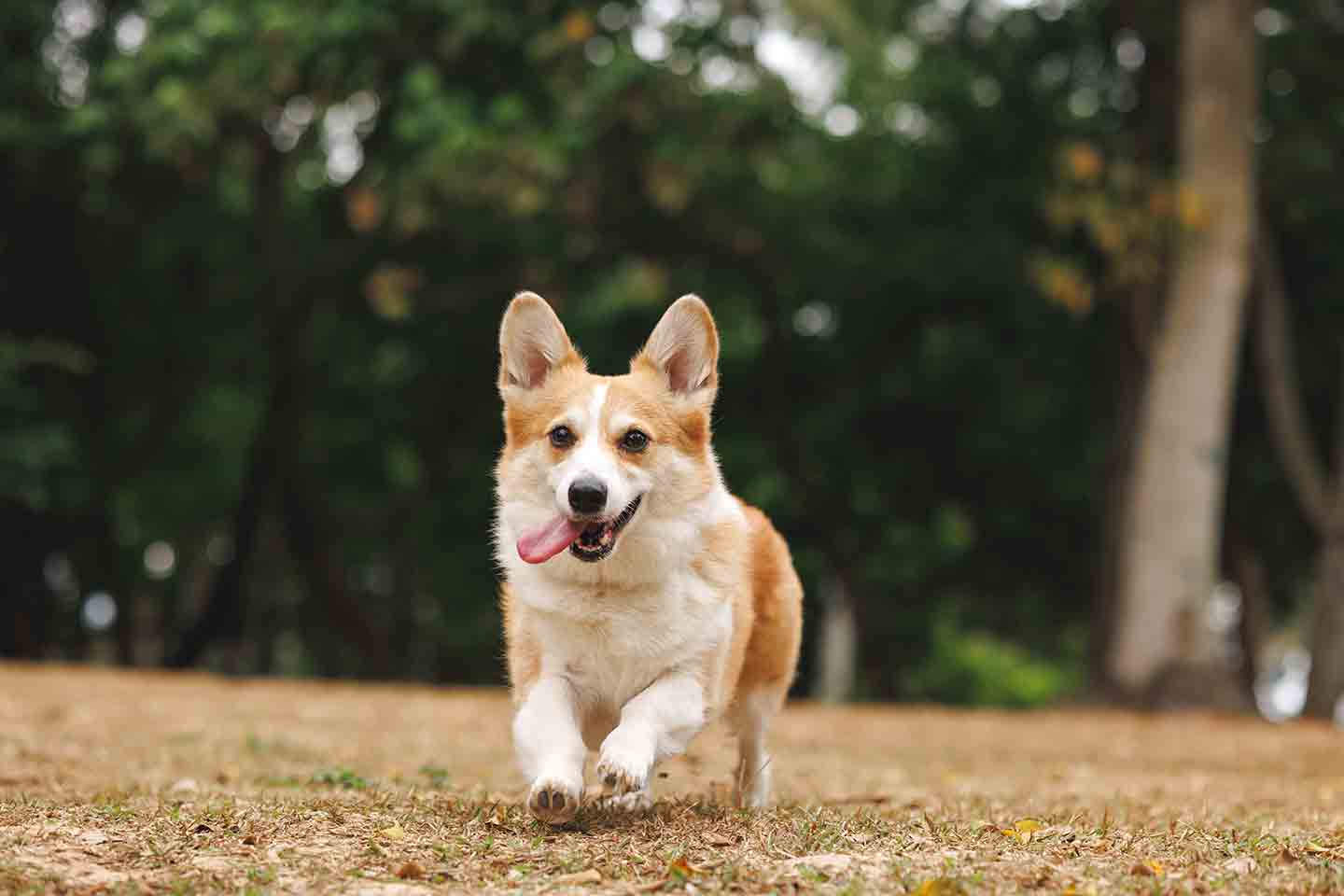
How to Train a Dog to Be Off Leash
Once dogs have mastered basic obedience commands and have reliable recall—meaning you trust they’ll listen to you no matter what and in any situation—you can consider taking them off leash. This provides them with more freedom to run and roam.
1Practice “Come” Indoors or In a Fenced Yard
The first place to practice off leash is in a safe, calm and quiet environment that you can control. Your home or a fenced yard is best. With your dog off leash, practice the “come” cue with an excited and happy tone of voice. You can also practice cues like sit and stay while they’re off leash in this safe environment.
2Make Coming Back a Joy
Make sure to provide positive reinforcement when your dog obeys any command while off leash. Give them delicious treats, lots of affection, and positive words. This creates a joyful experience for your dog when they come back to you or follow your cues.
3 Use a Long Leash in Public Settings
Once your dog has reliable recall in a fenced yard, you can graduate to a new setting. This might look like a nearby park or fenced dog park. Here, keep your pup on a long leash (20-30 feet) and continue practicing your commands. This provides safety and control while allowing your dog more freedom.
4Move Off-Leash
If your dog develops reliable recall, you can move to an off-leash situation. There may be hiccups along the way, but always practice patience; remember to use positive reinforcement; and never scold or punish your pup.
Why Do Dogs Run Away?
Dogs run away for all kinds of reasons, ranging from pure obliviousness and utter curiosity—they may not understand the dangers of the world and have a desire to roam and explore—to fear or feeling triggered to run in order to find safety. There are other common reasons, too. Let’s explore.
They’re Trying to Find a Mating Partner
Both male and female dogs can experience an intense desire to find a mating partner, and few things can keep them from tackling that mission, Wilson says. This is particularly true—and most common—in pets who haven’t been spayed or neutered.
In unspayed female dogs, hormonal changes occur when they go into heat, which can lead to an uptick in sexual behaviors and receptivity to mating. Unneutered male dogs, on the other hand, tend to exhibit more persistent sexual behaviors, including mounting and seeking out females in heat. Wilson says that this is one of many reasons why it’s so important to spay or neuter your pets.
They’re Naturally Explorative
Some dogs are just innate explorers and want to see everything the world has to offer. So if they get a rare chance to run out the front door or dig their way out of a yard? They might just seize the moment! Dogs who fall into this category tend to exhibit the following tendencies:
- High-energy pups, like Border Collies, Huskies, and Pointers, may have a strong desire to explore and may try to escape, particularly if they’re desperate for some physical and mental exercise.
- Dogs who were bred to have hunting and herding instincts, including Beagles, Australian Shepherds, and Greyhounds, can experience a strong urge to chase after prey or control their environment.
- Super independent dogs, like some Basenjis and Afghan Hounds, may feel less needy or not as attached to their owners, which can make them more prone to wandering off on their own.
- Many dogs thrive best in dog communities, and may be prone to running away, especially if they’re feeling isolated or lonely.
- Breeds known for their curiosity, such as Terriers and German Shepherds, might be more likely to explore their surroundings, and escape to investigate interesting scents or sights.
It's important to remember, however, that every dog is unique, and breed is not a determining factor in a dog's behavior.
They’re Dealing With Separation Anxiety
Though it may sound counterintuitive, Wilson says another reason dogs run away is because they’re experiencing an intense bout of separation anxiety.
“If they are not properly trained or conditioned to cope with being left alone, they may panic when the dog owner leaves,” Wilson says. “And on the flip side, never separating from your dog—even when at home—can cause the dog to bark and try to flee when finally left alone.”
When your dog is alone—even if for a short period—they may do everything in their might to try to escape. In their mind, running away accomplishes a handful of things: First, they’re seeking comfort and security, especially if they're feeling trapped or confined, and need relief from their overwhelming emotions. Running away may also let them explore and distract themselves from their feelings—and in some cases, they may be so stressed that they aren't thinking clearly.
They’re Scared
Even dogs who are not usually prone to running away may experience a desire to bolt when facing a scary trigger that tells their brains to flee for safety—for instance, a loud thunderstorm full of cracks and booms.
Fireworks, gunshots and even construction sounds can do the same. These sounds “can trigger a flight-or-fight response in some dogs,” Wilson says. “This instinctive reaction can lead to panicking dogs crashing through doors or windows trying to get away from the scary sounds.”
When out and about, small triggers such as an unfamiliar object—like an aggressive or rambunctious dog, an umbrella opening, or even a weird-moving balloon—can spook your pup and trigger them to dash.
They’re Bored or Lonely
All dogs benefit from routine physical exercise, mental stimulation and loving interactions with their parent. This is true of both low-energy pups and high-energy doggos. When they don’t get enough of these things, it can trigger behavior-related issues, with running away being a potential result.
To make sure your dog is getting the appropriate amount of mental and physical exercise, take them on long walks; spend time at the dog park; engage in training sessions to teach them new tricks; and introduce fun toys into your home.
What to Do If Your Dog Runs Away
If your dog runs away, do not panic. We know it’s a scary feeling—one that elicits a flurry of fears and what ifs in your mind—but safe reunification is very likely.
If Your Dog Runs Away When You’re With Them
If you’re with your pup when they run away, you may be tempted to chase them and yell out your dog’s name, but Wilson says this can actually make things worse.
“Chasing the dog is never a good idea, but running in the opposite direction and getting the dog to chase you could work,” she says. “Try running with a toy or treat, and convincing your dog to run after you.”
It’s also important to use a calm, reassuring and upbeat voice—versus one that sounds angry or panicked. Dogs respond to the tone of their parent's voice, so try to sound as inviting as possible.
If Your Dog Runs Away While You’re Gone
If you return home to discover your dog has run away, there are a handful of steps you can take. Ideally, Wilson says, you’ve already put important measures in place that increase reunification chances.
“All pets should wear collars with identification and contact information,” Wilson says. “Microchipping is essential, too. Just remember to update your registered address if you move.”
When your dog goes missing, act quickly and swiftly by alerting and checking in with nearby shelters, rescues, vets and neighbors while getting the word out on social media. Make sure to use a very clear, up-to-date color image of your dog when sharing.
Along with contacting shelters and notifying people via social media, it’s a good idea to go house to house and let your neighbors know your dog has gone missing. Dogs can run far, but there’s a strong chance they’re not too far away—especially if they haven’t been missing very long.
As you’re walking from house to house, call for your dog using a gentle and upbeat voice, and carry their favorite treats with you. Check out our other tips on how to find a lost dog.
Should You Punish Your Dog for Running Away?
Once reunited with your dog, you may feel intense relief and joy—but also anger and frustration. However, never punish your dog for running away. That means no light scolding, yelling, “grounding” them, or punishing them in other ways such as taking away toys or not giving them attention.
“Your dog could relate the scolding to coming back to you,” Wilson says, “and that’s not a lesson you want to teach.” It also can take a toll on your bond, which can only exacerbate their tendency to run away.
How to Keep a Dog From Running Away From Home
Apart from training, there are additional steps pet parents can take to keep their dogs from running away.
- Secure your home and fenced yard: Look around your home and yard, and assess whether there are gaps in your fencing or other easy outs your dog can take, then make sure to fix them. Inside, double check that all windows and doors are secure.
- Supervise them when outdoors: If your dog is an escape artist or has a history of running away, supervise them closely whenever outdoors. This includes them spending time in your front or back yard, at the dog park, or on leashed and unleashed walks.
- Make your home safe and inviting: When home is a place they want to be, your pup will not be as inclined to run away. Stock up their toy collection; make sure they’ve got fresh water and yummy food; and give them all the cuddles.
- Curb separation anxiety: Dogs who experience separation anxiety are more likely to run away. Take steps to cure their separation anxiety. This involves gradually getting your dog used to being alone. Start with short periods of time, and gradually increase the duration. Keeping them in a quiet and peaceful part of the home when you’re gone, and having them wear a ThunderShirt, can also help.
- Provide exercise and mental stimulation: Give your pup lots of physical exercise and mental stimulation. Without these things, they can become bored and restless, and have a desire to burn their excess energy.
If you’re the parent of a runaway dog, you’re definitely not alone. Plenty of pet parents contend with this natural instinct in their pup. The key to keeping them safe and within your sights is to make sure they’re spayed or neutered; that your home is safe and secure; and that you’re doing what you can to address anxiety, fears and exercise needs they may have. If your dog escapes despite these efforts, it can be helpful to work with a veterinarian or a dog trainer to assist with dog obedience training.
Expert input provided by Sylvia Wilson, dog trainer and co-founder of Bark Busters International, which provides dog training across the United States, Canada, Australia, and other parts of the world.
More Training Tips
Share:
